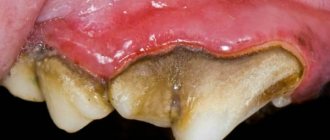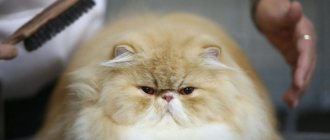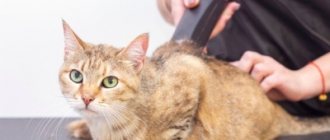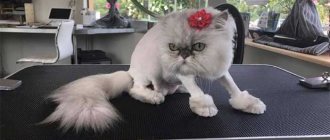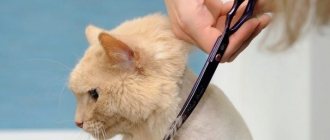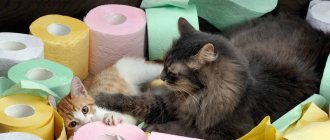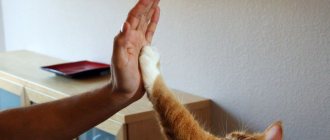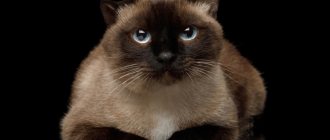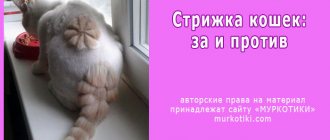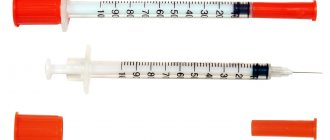Grooming cats at home: Types and features of cat hygiene
Many cat owners stoically endure periods when their pet sheds.
Wool throughout the house causes daily cleaning, and there is a need to constantly clean clothes after contact with your furry pet.
To get rid of such discomfort, there are grooming services that significantly reduce the shedding of the animal and make its appearance more tidy.
What is cat grooming?
Grooming is a set of procedures aimed at bringing the surface of a cat’s body into hygienic and cosmetic order.
In other words, this is a haircut - a process during which excess, too long hair is removed from the animal.
Professional grooming is performed by a specialist who uses specially selected tools for this purpose, such as:
- Hair cutters for cats;
- Massage brushes for grooming;
- Combs;
- Special hair dryers for styling animal hair;
- Rotary cars;
- Puffers;
- Furminators;
- Stripping knives;
- Wool rake;
- Thinning scissors;
- Nail clippers.
In almost every city there is a huge number of special salons that offer professional grooming services for any breed of cat.
Furminator for removing excess hair
Some breeders, in order to save money, learn grooming themselves by reading special literature and attending relevant courses.
Types of grooming
Grooming a cat is not as trivial a process as it might seem at first glance.
There are several types of this cosmetic procedure, each of which is designed to bring the pet into proper shape in accordance with the owner’s budget.
So, the types of grooming are as follows:
This type of grooming is the most popular and is done most often due to its practicality.
The purpose of hygienic grooming is to make it easier to keep your cat clean and tidy.
In this type of haircut, the pet's fur is trimmed evenly, the claws are trimmed with special nail clippers, and the excess hair between the pads and toes is cut off.
In addition, the groomer removes excess hair from the cat's ears and tidies up the hair near the genitals and anus.
- Home grooming;
Home grooming is mainly carried out by those cat owners who do not have a lot of free time to constantly care for their furry pet.
With this haircut, the cat's fur is trimmed slightly for a neater, neater appearance.
Plus, shorter coats are easier to maintain.
As the name suggests, this type of grooming is used mainly to prepare the animal for a specific exhibition.
The main task of a groomer who performs an exhibition haircut on a cat is to hide possible shortcomings and highlight the best qualities of the animal.
Grooming your cat improves its health and behavior
Features of grooming cats at home
Unlike getting a cat groomed at a salon or veterinary clinic, there is an alternative for every cat lover.
Now it is possible to call a professional groomer to your home to carry out the necessary procedures on the spot.
This type of grooming is very popular due to several features, including:
- Minimum stress for the cat - after all, grooming takes place at home and the animal feels calmer;
- Possibility of calling a groomer at any time convenient for the owner. The owner does not need to go with the pet to a salon or clinic or wait in lines;
- The specialist has all the tools necessary for professional grooming;
- Reasonable prices;
- No anesthesia or premedication during haircuts.
Your pet will be more comfortable with grooming at home
Typically, groomers have universal knowledge regarding animal haircuts, and can cut not only a cat, but also a dog if there is more than one pet in the house.
But unlike dog grooming , the price for grooming a cat is lower, and besides, specialists can cut any breed of cat .
The number of dog breeds that are cut by groomers is limited and depends on the specialization.
How to understand that a cat needs grooming?
As a rule, there are several factors that indicate the need for a groomer's intervention:
If a cat has a large number of mats, this leads to skin irritation and diaper rash.
If the problem is neglected, the animal may develop pockets of inflammation and flea “nests.”
Lumps, pellets, and matted fur are very difficult to comb - they bring discomfort to the animal’s life.
Under no circumstances should mats be cut off with scissors, as they can easily hurt your pet’s skin.
You should also not wash a cat with this problem - under the tangles, the skin dries slowly, and soaked skin easily becomes inflamed.
The most correct choice in this case is grooming.
- Cat health problems;
In cases where a cat has skin problems, grooming is necessary to trim the hair in the right places and make it easier to access the skin and process it more effectively.
Haircut is necessary for dermatitis, fleas, ear mites and increased secretion of the sebaceous glands (hyperplasia).
Grooming is also strongly recommended for cats who are unable to care for themselves due to illness or old age.
Maine Coon cats are especially fluffy
- Excessive hair loss;
If your pet sheds too much and often, grooming will significantly reduce the scattering of hair in the house and on clothes.
Typically, grooming is ordered by breeders with small children.
The absence of a large amount of cat hair in the house prevents the child from swallowing it and significantly reduces the likelihood of allergic reactions.
How often should cats be groomed?
The frequency of grooming primarily depends on the gender of the pet.
Females can be cut much less frequently than males.
This is due to the fact that cats devote much more time to licking and their appearance.
Cats, on the contrary, are less tidy and should be cut much more often.
Cats and cats should be groomed at different intervals.
The average cat can be trimmed every 6 months.
Cats usually need to be groomed three times a year.
This frequency will not lead to any undesirable consequences and will only have a beneficial effect on the cat’s well-being.
Frequency
The optimal frequency of trimming depends on the breed of cat: they differ in the length, thickness and speed of hair growth.
Most often (up to four times a year) long-haired breeds need grooming: Persians, Ragdolls, Siberian and Angora cats, Maine Coons. Cats with medium-length hair, for example, British and Scottish Fold, need to be cut once or twice, preferably before the warm season.
Unscheduled haircuts are required if mats have formed on the fur. They cause severe discomfort to the animal, tightening the skin and preventing air exchange, which can create a favorable environment for the development of skin diseases.
Alternatively, you can trim the tangles as they appear, but this method has two significant disadvantages: firstly, there is a risk of accidentally injuring the cat’s skin, and secondly, it can cause damage to the cat’s appearance.
What should you consider before grooming your cat?
- Grooming in any case is stressful for the cat, so you should not carry out grooming if there is no need for it in the form of health problems, falling fur or an upcoming exhibition. If there is still a need, breeders should consult a veterinarian or groomer about the possibility of using sedatives, or even anesthesia (sedation). Sedatives simply make the animal more docile, remove nervousness and allow the groomer to do his job. In some cases, their use is necessary, but not all groomers work with anesthesia. In any case, it is best to entrust this procedure to a veterinarian.
- You should not try to groom yourself. The main reason for this is that most owners do not have the necessary tools - ordinary scissors or a machine for cutting human hair will not work here. In addition, amateur grooming can physically harm the animal.
The most “violent” ones should be calmed down with anesthesia during grooming
- The best option would be to groom your cat at home, especially if she is nervous and does not like this procedure. The home environment will have a positive effect on the animal's calmness. In addition, it is convenient and less time-consuming (no need to waste time on transportation).
- Some cats change the structure and color of their coat after grooming. For example, it may become thinner and darker.
- In some cases, the pet's fur does not grow back to its previous length after grooming, or regrowth takes a very long time. These features are individual and depend on the general health of the animal, its breed and age.
- It is strongly recommended not to trim the cat's head, ears, whiskers and eyebrows. Also, do not completely cut off the hair from the tail.
- Since most cats react violently to grooming, their nails should be trimmed first to prevent wounds and scratches for the owner, the groomer and the pet itself.
Grooming for a cat is always stressful
Recommendations for different breeds
There are several subtleties based on the characteristics of the breeds.
When machine grooming cats with long, soft hair, you should go through each area several times, slowly, so that the clipper does not slip or get stuck.
Persian cats often react very aggressively to the procedure. To cope with the animal, you will need a skilled assistant.
If grooming is too stressful for your pet, it is better to avoid it.
British cats are short-haired and do not require hygienic grooming. Regular brushing provides them with proper care.
Angoras are cats with a very weak undercoat and require more frequent grooming than other breeds. Their coat is similar in structure to human hair, and its condition improves with regular grooming.
Maine Coons have a coat that grows very slowly. Among their owners, there are those who argue that these cats should not be cut at all, because the guard hairs may not recover after the procedure. Owners who decide to groom should be prepared for the fact that it will take a long time to grow the fur.
Types of model cat haircuts
A model haircut is more a desire of the owner, rather than a necessity.
For example, model haircuts are given to cats that are planned to be taken to an exhibition.
Some people believe that a haircut adds aesthetic beauty to a cat.
So, the most popular model cat haircuts are:
- “Lion” - the animal’s fur is cut off from its body, leaving only a “lion’s” mane on its head and a fluffy tip on its tail.
- “Puma” - the cat’s fur is cut off from the back, while the hair on the head, paws and tail is left untouched.
- “Dragon” - the pet is completely shaved, with the exception of the head and the peculiar “Iroquois” along the back.
The scope for creativity here is quite large, and the result depends on the creativity and skills of the master.
Grooming cats at home: Types and features of cat hygiene
Cat grooming at home is hygienic and cosmetic procedures designed to tidy up the surface of a cat’s body. Professional grooming is carried out by a specialist using special tools.
Cat grooming: features of the procedure
join the discussion
Share with your friends
Animal care professionals know what grooming is. However, recently this term has become vague, if not completely unclear. Some people, for example, believe that this is what they call grooming pets. Let's look at the nuances of the term, the features of the procedure, and find out who needs it, as well as how it affects the behavior of the animal.
Story
Grooming appeared in ancient times; initially, almost the only animals that were so carefully looked after were horses.
In medieval England, grooms were precisely those grooms who combed the hair of horses. With the advent of decorative long-haired dog breeds, groomers have more work to do. Poodles played a special role in the development of modern grooming, since this breed of dog requires careful and constant care for its coat. At the same time, the poodle needs to not only be bathed regularly, but also trimmed in a certain way. The breed experienced a surge in popularity in the mid-20th century. As a result, around this time, many grooming salons began to appear in the United States. Nowadays, grooming is considered the norm not only for dogs, but for almost all pets.
What it is?
Cat grooming is a complex of caring hygiene procedures. It includes not only a haircut, but also care for the pet’s fur, ears, eyes, skin and teeth. This is not at all a whim of the breeder, but rather a necessity to maintain excellent health of the pet. In addition to cleaning ears, teeth, eyes and grooming, it includes trimming nails. A specialist or the owner himself can carry out a set of measures to care for a cat, if he has the skills and the necessary equipment.
Varieties
Cat grooming can be classified into two types: hygienic and exhibition. The first type of care is aimed at ensuring and maintaining the cleanliness and health of the cat, giving the pet a well-groomed appearance. The care complex includes 7 different procedures:
- combing your pet's fur;
- swimming in warm water;
- wool cutting;
- cleaning ears;
- trimming long nails;
- eye wash;
- brushing your teeth
Exhibition grooming differs from regular grooming in that it is designed to bring a domestic cat to a certain standard established for a given breed. It is carried out by a professional groomer, paying more attention to the animal’s fur. This type of grooming is necessary mainly for cats that take part in exhibitions.
In this case, the master performs the haircut in such a way that the cat receives a minimum of unpleasant sensations.
Types: hygienic and exhibition
There are two main types of grooming: hygienic and exhibition. The first type of care is aimed at maintaining optimal hygiene for the pet. This grooming consists of a set of basic procedures:
☑️ swimming;
☑️ antiparasitic treatment;
☑️ combing and removing tangles;
☑️ trimming nails and cutting hair between fingers (for dogs);
and other hygiene procedures.
If the animal regularly participates in exhibitions, the second stage of hygienic grooming is exhibition grooming. It is aimed at giving your pet an ideal appearance. Exhibition grooming includes cosmetic procedures such as trimming, coat dyeing, special creative haircuts, and treatment of coat with shine-inducing products.
Exhibition grooming is usually carried out only a few times a year. While a pet constantly needs basic care. It is worth remembering that decorative grooming is impossible without first undergoing hygiene procedures.
Why do you need hygienic cat grooming?
Keeping your cat's fur clean is key to its health and well-being. If you do not pay proper attention to the care of the coat, it can become tangled. In addition, after grooming, the pet looks well-groomed, its fur shines and smells pleasant, which cannot but please the owner.
Necessary equipment
To carry out a set of procedures use :
- special combs;
- shampoo for cats and cats;
- nail clippers or nail scissors;
- cotton pads or napkins;
- ear cleansers;
- scissors or a wool clipper.
In addition, hydrogen peroxide and cotton wool should be on the workbench just in case. If the cat has long hair, fine-toothed combs, massage brushes, and gloves are used to remove loose hairs.
Additional coat care
When working with color, to emphasize the dignity of the color, special means are used for lightening, bleaching, adding tint, etc. If there is a lack of color, special toning preparations are used, for maximum contrasts - optical amplifiers, for shine - serums and sprays, for volume and texture - special shampoos and lotions, for silkiness and smoothness - conditioners and masks.
Working with texture: all cats' fur should feel lively and mobile to the touch, not heavy, porous and cottony. The groomer's task is to achieve the “perfect coat”. There are many lines of care products for different types and different lengths of hair. It is important to remember that texturing wool is a very subtle and delicate aspect, although it has a general concept. Different rocks have different thickness, length, structure and volume, and the texture preparations used for each of them are different. Often on the packaging there is an inscription: “texturizing”, which in fact is a drug that gives density, elasticity, and in some cases rigidity. For example, such a drug will work great for a Siberian or Norwegian forest cat, but is completely unsuitable for cats with soft fur. And, on the contrary, preparations for the silky shiny soft coat of a Bengal cat are absolutely not suitable for a British cat, who will immediately lose his “crispy” crispy springy coat and volume. It is very important to select texture preparations for each specific cat in advance.
When is it needed?
In general, a complex of caring procedures is always needed. However, there are times when immediate haircutting is required. For example, cats need grooming:
- before an upcoming operation or procedure associated with the need to cut hair in certain places;
- if your pet has skin diseases that require access to the skin;
- in case of heat , if the cat has long hair and there is a risk of body overheating;
- if there are small parasites (fleas, ticks) in the fur;
- when feces stick to the fur near the hind legs and tail of long-haired cats;
- a cat that swallows a lot of hair when licking its own body;
- in the case when the animal’s fur becomes matted , but there is no time for constant combing.
In addition, a cat’s haircut is also necessary if the owner is allergic to cat hair, which can be a carrier of the allergen. This procedure allows you to reduce the concentration of allergenic protein, coupled with constant cleaning of the house. It is necessary to cut the animal even when the owner is unable to provide proper care for the pet’s coat. Otherwise, cats need to have their hair cut more often for medical reasons.
The cat itself cannot lick itself completely, which is bad for the condition of the coat and skin. For example, she will not clean her own ears, she will not be able to clean her eyes, and she will not be able to trim her claws. Timely grooming is the prevention of various diseases.
Is it worth doing this?
First you need to make the right decision: whether to cut your cat's hair. Not all cats require this type of care. Some longhairs live well their entire lives without ever visiting a stylist.
But if your cat's hair is matted, trimming is the way to go. The best option in this case is professional haircuts done in pet salons. A grooming specialist will carry out the procedure quickly and efficiently, and will select the best hairstyle for your pet.
But there are times when you really need to rid your pet of long hair, and a good groomer is not available at that moment. Then you can gain strength, caution, prepare and cut your cat’s hair yourself.
Why do you need to cut your hair?
It is worth trimming your cat's body hair if someone in your household is allergic to cat hair. The cat may also develop mats or begin to shed. In these cases, you can also solve the mentioned problems. You should avoid unnecessary shaving in the following cases:
- Your cat's fur is good at regulating body temperature in both summer and winter. If you remove too much hair from an animal, you may disrupt this process.
- A long-haired cat just needs a bath to cool it down in the heat.
- Not all cats need to be clipped. Severely aggressive, elderly or sick cats may be subject to stress or cuts during shaving.
Consider professional performance
Sometimes it is best to find out the location of grooming salons in your city and the cost of their services. This may be the best option for your pet. Grooming specialists know well how to care for a cat's coat. Therefore, it is better to entrust the haircut to a professional. Although the cost of getting a haircut at a salon can be quite high, it is worth it. Groomers are less likely to accidentally cut your cat and know how to keep pets calm during the grooming process.
- Prices vary depending on what service you need. If you want a basic treatment (rather than a full cut), the cost will be lower.
Consult your veterinarian
Before grooming your cat, consult your veterinarian. If mats have formed in your pet's fur, your veterinarian may prefer to remove them yourself. In addition, your pet doctor may advise you not to cut your cat's hair, to do it only during certain seasons, to give recommendations on grooming for the groomers themselves and on the choice of tools.
Cat behavior
It is impossible to say with certainty that cats love grooming. And the point here is not so much in the fear and restlessness of animals, but in their upbringing and mood. If a kitten has been accustomed to basic hygiene since childhood, it will sit quietly while its fur is combed out, its ears are treated, and its teeth are brushed. A cat being groomed for the first time will become nervous.
Treatments in the salon begin with nail trimming, to which even a trained cat reacts differently. But when it comes to haircuts, few pets have a positive attitude towards it. Some individuals consider this humiliation, and therefore avoid the procedure for a long time. For them, such a procedure often results in stress and sometimes loss of appetite.
It is necessary to accustom a kitten to hygiene from the age of two to three months, gradually incorporating new types of procedures into home cat grooming. During grooming, a cat may scratch, bite, twist and try to escape. In some cases, after the procedure, its stress can develop into a problem such as the appearance of bald patches that will not heal. A cat may become nervous at the sound of a clipper or even a hair dryer.
Some pets may try to bite the groomer while he is bathing them. There is no need for wild haircuts, which can cause ridicule of your pet. Cats sense intonation very accurately; they understand not only a stern voice, but also the manner of conversation. Neither a haircut like a lion nor any other animal will give your pet confidence. They feel most confident with their own fur.
Express - shedding in dogs
What it is? The good old procedure of combing dogs, plus washing, plus blow-drying was called Express Shedding by someone else. Who needs it? Well, first of all, I would like to say - for dogs with a double coat type, such as Spitz, Chow Chow, etc. For dogs with medium length, for example, shepherd dogs, Pekingese, Akita Inu, Shiba Inu, it can also be carried out, especially in spring and autumn, when flakes of fluff begin to cover the floors of your shared home. But a HUGE WARNING - look for grooming salons where masters use classic combs and slickers to comb dogs, and in no case a mechanical machine called FURMINATOR. Watch a detailed video about its dangers on our YouTube channel. Let's say one thing - more and more often animals come to us after other masters, whose molting was carried out with a furminator, which caused cicatricial alopecia, as a result of which the hair does not grow in places for a year, exactly after some salons and schools , due to not understanding the problem, began using it for the combing procedure, which contradicts not only the manufacturer’s recommendations, but also basic common sense. Be vigilant and careful.
Nuances of procedures
Grooming a cat is one of the key stages of grooming. At the same time, an unenlightened layman may not know some points that are important to pay attention to. For example, you cannot cut an animal’s head or trim hair from its ears and whiskers, since there is a high probability of damage to the whiskers . In addition, you cannot completely cut the hair from the tail, because cats constantly gnaw on it, and therefore can cause serious injury to themselves.
During grooming, a specialist often reveals the presence of problems such as incipient dermatitis, increased greasiness of the coat, and vitamin deficiency. As a rule, the cat stands on the table during grooming. Other “clients” are placed on their side, and after treatment – on the other side. After grooming, cats are bathed and then, at the client’s request, they take care of their ears, claws and eyes.
Rarely do animals behave too calmly: this is typical of those cats who adore having their fur brushed, constantly stroked and cherished. Often, when trying to trim their fur, cats become aggressive. This is a natural protective reaction, and therefore the groomer sometimes needs an assistant to hold the animal while its hair is cut. However, there are restrictions that exclude some stages of hygienic manipulations.
For example, you should not cut or bathe an animal if the room is cool, as the pet may catch a cold. You cannot abruptly perform the entire set of procedures if the animal is not accustomed to them. You need to do the preparation gradually: you can start with short visits, treating the cat at each stage of grooming. You can skip something, allowing your pet to get used to the environment and manipulations, so as not to provoke stressful situations in the future.
To reduce a cat's resistance to grooming, some salon technicians use muscle relaxants. The drugs do not immobilize the animal, but reduce its activity, as a result of which the pet’s reactions become inhibited. Essentially, the cat is given an injection after choosing the right type of drug and the required dosage.
After this, the specialist monitors the “client’s” condition, however, such a procedure can negatively affect the pet’s health.
Other groomers use a leash, putting it on the cat while grooming. Still others prefer a special bag-retainer, which simplifies various manipulations by a specialist. Bags are used to simplify injections into any of the limbs, care for the ears and eyes. In essence, this product is somewhat like a straitjacket for a violent pet.
It is worth noting that not all stages of grooming need to be performed constantly. For example, it is not recommended to do a haircut more than once every 3 years. In addition, no matter how much you want to make your cat special, you need to understand that this is, first of all, a last resort, and not a change in appearance through a model haircut.
It’s one thing when a cat is cut for medical reasons, but it’s quite another thing for its own amusement, because the animal can take a long time to recover from the stress “given” by its owner.
How is it going?
If a haircut is necessary, it begins after treating the claws and injecting a special preparation. For cutting, use a clipper and scissors, paying special attention to the armpits and abdomen. At the end of the haircut, the animal is bathed, its fur is dried, and then it is combed out. You need to wash your cat well so that there are no cut hairs left on his body.
The specialist selects a washing shampoo and begins bathing the cat. After bathing, he wraps her in a towel to dry her fur. Other masters use a hairdryer to speed up the procedure. If necessary, a haircut is performed, which is selected based on the length of the coat and the preferences of the owner.
Sometimes pets need trimming, which involves comprehensive hair care with the removal of old hair and cutting out specific hairs. For example, some individuals have the hair between their toes trimmed . This should be done carefully so as not to injure the animal. When doing ear and eye hygiene, the master will tell the owner that this needs to be done daily.
If the cat has diseased organs, antiparasitic treatment is performed to remove purulent discharge. If the wool is matted, they are removed, the wool is combed for a long time, using different combs and brushes. If the cat does not have hair (hairless breed), instead of cutting and combing the fur, the master pays attention to places where dirt may accumulate in the folds of the skin. These cats need frequent baths.
As for the ears and eyes, they are cleaned using chamomile infusion or boiled water. Earwax discharge is removed using a damp cotton swab or disk. Get rid of dust particles and dirt in the corners of the eyes using wet wipes soaked in boiled water. The claws are trimmed with a nail clipper to no more than 1.5 mm.
As for removing tartar, this should only be done by a specialist. Ideally, you need to brush your cat’s teeth with a special paste and brush every day. However, it is rare that a breeder can do this on their own, and not everyone knows that the paste for cleaning cats’ teeth is different from the one that people use.
Preparing the cat before the show (1-2 days before)
The show grooming procedure is performed on cats 1-2 days before the exhibition, this allows the coat to be clean and tidy for a long time during the exhibition. The preparation algorithm for all breeds is the same, but there are significant differences in colors, texture and breed haircuts, trimming.
The basis is a basic three-stage complex - degreasing-shampoo-conditioning. Before the last stage (application of conditioner), preparations for working with pigment, color and preparations for volume and texture are added, if necessary. For example, all native cats have a specific guard coat, which creates a glossy, shiny coat that lies on an abundant, dense undercoat. The main task of the owner and groomer is to create and highlight this coat. The Ragdoll has a very soft, silky and voluminous coat, for which soft, delicate shampoos are quite sufficient. The Devon Rex and Cornish Rex have curly, ultra-short hair, which needs to be softened as much as possible with silky shampoos and serums, while the British cat needs to use texture preparations for greater elasticity. It is very important after water treatments to dry the coat thoroughly with a hairdryer or compressor, and then apply a moisturizing antistatic spray.
Brachycephalic cat breeds (Persian, exotic) have a breed-specific need for haircuts and trimming of the head, chin, cheeks and collar in order to create a sweet facial expression and an open, childish look. The hair on the tips of their ears is also trimmed to give them a rounded shape as much as possible, the tufts of hair on their paws are carefully selected, and the tip of the tail is also rounded using thinning scissors and special knives. Many cat breeds are subjected to trimming and pedigree haircuts, most often selective breeds of cats: Scottish, British, Selkirk Rex, Oriental, Somalia.

